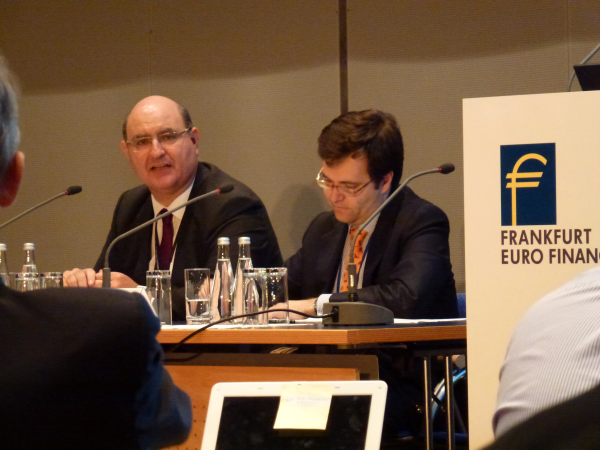Part 2 of an extensive interview with Carlos Montalvo, Executive Director of EIOPA, in which he discusses the EIOPA Guidelines and the challenges of preparing for Solvency II while details of the Level 2 text are still to be finalised.
—
The lobby of the Hotel Villa Magna in Madrid is an open yet somehow strangely labyrinthine space. The marble floor and dark walls ooze from the entrance through a set of glass cabinets displaying a mixture of jewellery and memorabilia, the sort these types of hotels have, into the vast open plan café. As it is the holiday season most of the guests are tourists and visitors from out of town, so our conversation about Solvency II is set to a background of light chatter and an occasional child’s shrill squawk.
We move on. There is only so much of the past one can rehash and draw lessons from without getting stuck in a rut. It would be more productive to try to take those lessons on board because Solvency II is not yet “in the bag”, as they say.
The Guidelines, a mastertroke

In addition to the 1 January 2016 implementation date, the agenda for the next two years will be dominated by EIOPA’s Guidelines for the Preparation of Solvency II.
The Guidelines were a masterstroke by EIOPA putting the implementation of Solvency II on a win-win track. They were developed after the breakdown of the trilogue negotiations in the Autumn of 2012 when, for a while, there was a serious danger that Solvency II would fizzle away, lost in the quagmire of Euro-politics. EIOPA introduced the Guidelines at the end of that year with the dual purpose of preserving momentum (if uncertainty persisted) and as a tool for preparation for full implementation (should 2016 be agreed on). Now that a political agreement has been reached the balance has shifted towards the latter.
At the time we spoke in Madrid, EIOPA was waiting for the results of a comply or explain exercise in which National Supervisory Authorities had to declare their intentions in relation to the Guidelines. If they do not intend to comply they must give an explanation, but there are limited powers to enforce the Guidelines.
A number of Member States had already made their intentions clear, including some non-compliance. “The objectives of the Guidelines are precisely to facilitate at the supervisor level and at the company level preparation for Solvency II,” Mr Montalvo says.
“Until now they were also a bridge in order to keep the momentum with regards to Solvency II, but also to make sure that we wouldn’t keep postponing things for tomorrow.” He makes a reference to an article by the 19th century Spanish writer Mariano José de Larra, called ‘Vuelva usted mañana” (Come Back Tomorrow), a parable about malaise and procrastination, which he uses to emphasize the need to start Solvency II work without delay.
“We wanted to make sure that it was today rather than tomorrow that people would start implementing steps towards what is going to be their own business as usual regarding Solvency II.”
I wanted to know if EIOPA would take action against those Member States that said they would not comply with some of the Guidelines.
By definition when it comes to Guidelines you are not taking action of punishment or anything like that. The Guidelines are addressed to National Supervisory Authorities and they must decide what to do. If they want to comply, it is also up to them if they want to do it through supervision or through regulation.”
Today as I write, the results of the comply or explain exercise are known. The majority of Member States said they will either “comply” or “intend to comply” with almost all of the Guidelines. The fact that some will use supervision rather than regulation (changing existing rules) means EIOPA will have its work cut out for it in terms of coordinating consistent application and preparation. Mr Montalvo explains that in cases of non-compliance, EIOPA would look to understand the reasons (the results show these are often because of a lack of appropriate legal framework) and try to address the issue bilaterally.


Apart from the Omnibus II agreement there are two other factors supporting the broad acceptance of the Guidelines. The first is that they were approved by the EIOPA Board of Supervisors, which is made up of members of these authorities.
The second is that several countries have been planning to modernise the supervision of their insurance market through Solvency II. The on-going delays and uncertainty mean they cannot wait any more. Not withstanding the overwhelmingly positive response to the Guidelines it remains to be seen how individual firms will react and if there be a real take-up on the ground.
Do you think the number of companies that comply with the Guidelines will affect their outcome or EIOPA’s work?
“The number of companies that do comply or do not comply – that is an issue for the local supervisor.”
He explains that EIOPA will stand ready to help in these cases, but clarifies that issues at the company level will be dealt with locally. “If, say, in this local market you see that many of the companies are not fulfilling the request of the regulator, then it will be up to the regulator to act. And then that regulator can also come to us and say, ‘well, we have this issue with the companies what does EIOPA think?’”
A flavour of what is to come may be gained from responses in France and Germany. France has made it clear that it expects significant participation from firms, even though it is currently unable to comply with the Guidelines on Governance, as they require a change to the legal framework. At the same time it is putting high emphasis on reporting and the ORSA.
Germany is also indicating that it expects high levels of participation. At the EIOPA conference last year Felix Hufeld, Chief Executive Director Insurance Supervision at BaFin, said that the regulator will expect to see progress during the preparatory phase, but if it got the impression that less than half the market was moving forward it would, “most definitely apply a different style of supervision”. Earlier this year BaFin already announced that it intends to apply the Guidelines to all firms, beyond the thresholds set by EIOPA.
But in other Member States that have surged ahead with preparation for Solvency II in the past, there is something of a credibility problem. In the UK, for example, the regulator strongly encouraged firms to be ready for the then 2013 deadline. Many firms pressed on with the work only to see the timeline slip, resulting in considerable cost and disruption to operations. Now they simply do not believe that this time is different and rightly fear further changes and time slippages.
Companies across the EU have also been expressing concerns that the Guidelines will be an additional burden and a duplication of work. “I think it’s a very legitimate concern. But I also think that we supervisors have something called common sense. What we did at the beginning of this year [2013] was to include in the preparatory Guidelines package those Solvency II elements that were ‘stable’, that would not change subject to the Omnibus II agreement.”
However, Mr Montalvo admits that some modification is inevitable. “You may find, for example in the area of reporting, some changes linked to the outcome of the LTG. Well you can be sure that EIOPA will provide all the templates adjusted to the companies in due time for them to perform basically these preparatory exercises in 2015 for 2016.”
Those who argue that the Guidelines will cause duplication point out that areas like reporting are especially vulnerable, as designing large scale systems that may have to be adapted at a later date will be costly. And while firms can comply with many of the ORSA requirements, the main problem is the link to the capital calculation, around which significant uncertainty remains.
Another family drifts past our table through the open space of the café. Again I am conscious of the curled up biscuit that dropped on the table. Its awkwardness has come to embody those uncertainties and seeming impossibilities of Solvency II for me.
EIOPA said it would apply the principles of proportionality to the Guidelines. I asked him what that means and he is keen to stress two points about proportionality.
“The first one is that proportionality is a two-way road. It is not only for small companies, it is also for very large companies. We do expect that very large companies fulfill the same criteria in a different way. That they don’t go with a partial model, that it is only looking at, lets say, one sub model of the credit risk, because by coincidence, well, it doesn’t seem to balance.”
The second point he makes is that applying the rules in a proportionate way must maintain the same level of policyholder protection. It is not a way to water down the rules. “To say that proportionality should be different, it’s a mistake. It’s the same rules applied in a different way.”
Mr Montalvo concedes that Solvency II is not a simple framework and stresses that EIOPA is open to listening to industry suggestions on where proportionality can be applied appropriately. He adds that EIOPA sees its role in making things a little easier for companies.
“We want to make sure that we keep having good dialogue with companies in terms of what makes sense, but we also want to make sure that proportionality doesn’t lead to a reduction in the level of protection for policyholders because that could kill the small company market.”
He explains that if the level of protection would differ, consumers would prefer the undertakings giving them higher reassurance. This is why the whole approach is based on same rules with a different way to implement them rather than different rules.
The clear Madrid winter sun blazes through the glass walls of the café. You could almost be excused for forgetting how icy cold it is outside. When we sat at our table Mr Montalvo commented on the stunning bright sunlight, something he clearly misses being based in Frankfurt. He speaks of it fondly, as if it was another of the city’s magnificent attractions. I share the sentiment. ‘The Paseo del Prado, the Palacio Real, and over here ladies and gentlemen, above your heads … the sun’.
Uncertainties casting shadows

The application of proportionality is all well and good but the final shape of the rules will also depend on the Level 2 text of the Directive, the so-called Delegated Acts. And as these have not yet been finalised another concern is that material changes to that text will affect the Guidelines.
“We expect that the European Commission already considers that most of the framework is stable. As long as most of the framework is stable no fundamental changes should come and as long as that doesn’t happen you will have basically the same elements in the Preparatory Guidelines as in the final Guidelines.”
All the indications so far from the Commission have been that it will look to limit the changes to the Level 2 text. At the last EIOPA conference Klaus Wiedner, Head of the Insurance and Pensions Unit of the European Commission, reinforced previous messaging that the Commission does not intend to reopen the entire text for negotiation.
More recent indications, and a draft circulated to stakeholders in mid January, would suggest they have kept true to their word.
However, Mr Montalvo does sound a word of warning – harking back to the earlier part of our conversation – of the danger that industry lobbying could derail the process. “Looking forward I see that as a risk [that] the industry comes with again a massive shopping list in terms of things that they think are fundamental for the project because otherwise Solvency II will be a failure. It sounds like an old tune in terms of thirteen years of Solvency II process.”
EIOPA is not involved with drafting the Delegates Acts but it is tasked with drafting several Implementing Technical Standards (ITS), which are also part of the Level 2 text. These cover a range of topics from special purpose vehicles, counterparty risk and look-through for SCR calculations, to external credit assessments, health risk and supervisory transparency and accountability. EIOPA must consult on these texts publicly and then present the ITS to the Commission for final approval.
“Because they are Implementing Technical Standards, the European Commission has the right, if they think they basically fundamentally diverged from the acquis communautaire, to say, well, this is against the Level 1 text for example. We cannot accept it. In which case a new process will be triggered in which the European Commission, the European Parliament and the Council will be involved. It is a bit of a committology-lite type of approach.”
Here too it is clear that the familiar trappings could emerge. “But the idea, from EIOPA’s viewpoint, is, again, let’s leave technical issues to technical people not to the political level. As EIOPA we are committed to not entering in political issues, but stick to the technical work, and I am happy to say that we have managed to do so. Let’s work on that. Let’s do credible work. Let’s consult it and let’s present it to the European Commission. So that there will be a possibility for companies not only to understand but also share their views.” The pace of his delivery quickens a bit. Although he is clearly passionate about his work he strikes me as too much of a technocrat to express his emotions, but if he did I think this would be as close as it gets.
The Solvency II to do list is exhausting but by no means exhausted. EIOPA has now published a timeline for the consultation on the ITS and additional guidelines that it will have to draft and consult on publicly by the summer of 2015. I point out that the timeline is extremely tight even with the early consultation by EIOPA. “I agree,” he says, “but is that EIOPA’s responsibility? No. I mean we are bound by the same strict timeline that is a consequence of, let’s say, the whole process as anyone else. We want to make the best use of this timeline, which is extremely challenging. Extremely challenging.”
Realising the challenges and the workload for both rule makers and industry, makes that semi-euphoric tweet from Sharon Bowles from that night last November seem like a faint starting shot for another long journey. At times the path of the Directive appears as convoluted and labyrinthine as the lobby of the Villa Magna – obscuring the light of the Madrid winter sun.

In Part 3 Mr Montalvo discusses transparency, look-through and the legacy of Solvency II.
Part 1: Two lessons from Solvency II
Part 2: Getting ready for Solvency II
Part 3: Transparency and legacy





